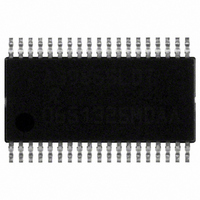A3985SLDTR-T Allegro Microsystems Inc, A3985SLDTR-T Datasheet - Page 10

A3985SLDTR-T
Manufacturer Part Number
A3985SLDTR-T
Description
IC MOSFET DRVR PROG DUAL 38TSSOP
Manufacturer
Allegro Microsystems Inc
Datasheet
1.A3985SLDTR-T.pdf
(15 pages)
Specifications of A3985SLDTR-T
Configuration
H Bridge
Input Type
Non-Inverting
Delay Time
120ns
Number Of Configurations
2
Number Of Outputs
8
Voltage - Supply
12 V ~ 50 V
Operating Temperature
-20°C ~ 85°C
Mounting Type
Surface Mount
Package / Case
38-TSSOP
Device Type
Full Bridge
Module Configuration
Full Bridge
Peak Output Current
500nA
Output Resistance
19ohm
Input Delay
120ns
Output Delay
120ns
Supply Voltage Range
12V To 50V
Lead Free Status / RoHS Status
Lead free / RoHS Compliant
Current - Peak
-
High Side Voltage - Max (bootstrap)
-
Lead Free Status / RoHS Status
Lead free / RoHS Compliant, Lead free / RoHS Compliant
Other names
620-1180-2
Available stocks
Company
Part Number
Manufacturer
Quantity
Price
Part Number:
A3985SLDTR-T
Manufacturer:
ALLEGRO/雅丽高
Quantity:
20 000
A3985
gramming the Fast Decay Time bits in the Control register
(Word1, Bits D8 through D11). If t
the device effectively operates in full fast decay mode.
Selecting between slow decay and mixed decay is done by
programming the Mode bits in the Data register (Word0, Bits
D8 and D16) using the serial port.
Synchronous Rectification
is triggered, load current recirculates according to the decay
mode selected by the control logic. The synchronous rectifi-
cation feature turns on the appropriate MOSFETs during the
current decay and effectively shorts out the body diodes with
the low R
sipation significantly and eliminates the need for additional
Schottky diodes.
Synchronous rectification can be set to one of three distinct
modes by programming the Synchronous Rectification bits
in the Control register (Word1, Bits D14 through D15) using
the serial port. The modes are:
Shutdown Operation
ture fault, or an undervoltage fault on VREG, the gate drive
outputs are disabled until the fault condition is removed.
At power-up, and in the event of low voltage at VDD, the
under voltage lockout (UVLO) circuit disables the gate drive
outputs until the voltage at VDD reaches the minimum level.
Once VDD is above the minimum level, the data in the serial
port is reset to all 0s, ensuring a safe power-up condition.
Serial Interface
The A3985 is controlled by a 3-wire serial port using data,
clock and strobe inputs on the SDI, SCK and STR pins
respectively. An additional serial data output on SDO can
• Active This mode prevents reversal of the load current by
• Passive This mode allows reversal of current, but will
• Disabled During this mode, MOSFET switching does not
turning off synchronous rectification when a zero current
level is detected. This prevents the motor winding from
conducting in the reverse direction.
turn of the synchronous rectifier circuit if the load current
inversion ramps up to the current limit, I
occur during load recirculation. Usually, this setting would
only be used with 4 additional external clamp diodes per
bridge.
DS(ON)
of the MOSFET. This lowers power dis-
In the event of an overtempera-
FD
When a PWM off-cycle
is set longer than t
TripDAC
.
OFF
Dual Full-Bridge MOSFET Driver
,
be used to connect several A3985s in a serial daisy chain.
The programmable functions allow maximum flexibility in
configuring the PWM to the motor drive requirements. The
serial data is written as two 19-bit words: 18 bits of data plus
1 bit to select the destination register.
Serial Port Write Timing Operation The serial port tim-
ing requirements are specified in the electrical characteristics
table, and illustrated in the Serial Data Timing diagram.
Data is received on the SDI pin and clocked through a shift
register on the rising edge of the clock signal received on the
SCK pin. STR is normally held high, and is only brought low
to initiate a write cycle. No data is clocked through the shift
register when STR is high.
The 18 data bits for a register are input MSB first, fol-
lowed by the register select bit, D0. After D0 is clocked
into the shift register, STR goes high to latch the data into
the selected register. When this occurs, the internal control
circuits immediately act on the new data.
The Control register can only be written if the WC pin is at
logic low. If WC is high and D0 = 1 (indicating the Control
register), the data will be ignored on the rising edge of STR.
The state of the WC pin does not affect writing to the Data
register, and the pin can be tied to GND when Control regis-
ter protection is not required.
Note that the number of bits clocked through the shift reg-
ister is irrelevant and only the last 19 bits before STR goes
high will be latched. This allows several A3985 devices to be
daisy-chained and updated together with a single STR rising
edge.
Data Register (Word 0) Bit Assignments
This section describes the function of the individual bit
values in the Data register, one of the two registers accessed
through the serial port. The assignments are summarized in
the Bit Assignments table.
D0 – Register Select Indicates which register should
receive the data. For the Data register, this is set to 0.
D1 through D6 – Bridge 1 Linear DAC These six bits
set the desired current level for Bridge 1. Setting all six bits
Digitally Programmable
115 Northeast Cutoff
1.508.853.5000; www.allegromicro.com
Allegro MicroSystems, Inc.
Worcester, Massachusetts 01615-0036 U.S.A.
10
















